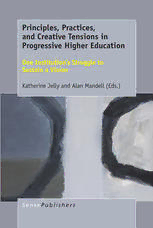
Principles, Practices, and Creative Tensions in Progressive Higher Education: One Institution’s Struggle to Sustain a Vision PDF
Preview Principles, Practices, and Creative Tensions in Progressive Higher Education: One Institution’s Struggle to Sustain a Vision
Principles, Practices, and Creative Tensions in Progressive Higher Education Principles, Practices, and Creative Tensions in Progressive Higher Education One Institution’s Struggle to Sustain a Vision Edited by Katherine Jelly and Alan Mandell A C.I.P. record for this book is available from the Library of Congress. ISBN: 978-94-6300-882-2 (paperback) ISBN: 978-94-6300-883-9 (hardback) ISBN: 978-94-6300-884-6 (e-book) Published by: Sense Publishers, P.O. Box 21858, 3001 AW Rotterdam, The Netherlands https://www.sensepublishers.com/ Cover image: If the Shoe Fits, Joan Mellon, 2013; oil on paper, 7 × 10.25 inches Printed on acid-free paper All Rights Reserved © 2017 Sense Publishers No part of this work may be reproduced, stored in a retrieval system, or transmitted in any form or by any means, electronic, mechanical, photocopying, microfilming, recording or otherwise, without written permission from the Publisher, with the exception of any material supplied specifically for the purpose of being entered and executed on a computer system, for exclusive use by the purchaser of the work. TABLE OF CONTENTS Acknowledgements ix Introduction: Creative Tensions in Progressive Higher Education: Theories and Practices in a Changing Context 1 Katherine Jelly and Alan Mandell Section I: Underlying Principles, Ideas and Values: Perennial Questions 1. Empire State College and the Conflicted Legacy of Progressive Higher Education 29 Wayne Carr Willis 2. Conflict, Change, and Continuity: ESC’s Goddard College and British Open University Connections 43 Richard F. Bonnabeau 3. John Dewey, Constructed Knowing, and Faculty Practice at Empire State College 65 Xenia Coulter Section II: Student-Centered Pedagogy: The Mentoring Model and What It Has Meant 4. Is the Authority in the Dialogue? A Memorandum 93 Lee Herman 5. Educational Planning at Empire State College: Fluidity vs. Structure, Process vs. Product 111 Susan Oaks 6. Interdisciplinary Education at Empire State College: Many Opportunities, Ongoing Challenges 133 Lorraine Lander 7. The Cipher and Empire: Teaching and Mentoring through Hip-Hop 149 Himanee Gupta-Carlson Section III: Let 1,000 Flowers Bloom: Our Students and the Programs and Procedures That Support Them 8. “I Don’t Write, I Work”: Writing and Reading with Trade Union Apprentices 167 Rebecca Fraser and Sophia Mavrogiannis v TABLE OF CONTENTS 9. A Progressive Institution Takes on Academic Support, 21st Century Style 183 Seana Logsdon and Linda Guyette 10. On the Leading Edge: International Programs and Mentoring in Transnational Settings 201 David Starr-Glass 11. Inherent Tensions within the Practices of Prior Learning Assessment at SUNY Empire State College 215 Nan Travers Section IV: Organizational Frameworks: Infrastructure, Culture, and Change 12. Organizational Complexity in a Progressive Educational Environment 243 Lynne M. Wiley 13. Technology Meets the Local: One Mentor’s Reflections on Autonomy and Connection in a Dispersed Institution 255 Chris Rounds 14. Family Feuds, Shotgun Weddings and a Dash of Couples Therapy: The Center for Distance Learning/Metropolitan Center Blended Learning Initiative 273 Sarah Hertz, Cathy Leaker, Rebecca Bonanno and Thalia MacMillan 15. Growth and Its Discontents: Organizational Challenges to a Radical Vision 295 Cindy Conaway and Christopher Whann 16. At a Crossroad: The Shifting Landscape of Graduate Education 313 Barry Eisenberg Section V: Empire State College in a Broader Context: The Impacts of External Forces 17. Empire State College: Exceptionalism and Organizational Change in the SUNY System 339 Edward Warzala 18. Current Technologies and Their Uses at Empire State College: Benefits, Costs, and Possibilities 357 Betty Hurley vi TABLE OF CONTENTS 19. Implications of Emergent Content, Experimentation, and Resources for Outcomes Assessment at Empire State College 375 Joyce E. Elliott Afterword: Living the Questions to Sustain the Vision 393 Alan Mandell and Katherine Jelly About the Contributors 399 Index 407 vii ACKNOWLEDGEMENTS Many people contributed to this project. We thank them all very, very much: to Bob Carey, Morris Fiddler and Connie Krosney, for their helpful input at the early stages of organizing this book; to Karen LaBarge, for her genuinely helpful and meticulous attention to detail and for her thoughtful questions at every turn; to Terri Hilton, for her support in helping us to keep track of early correspondence; and to the authors of these chapters, for their ideas and insight, their interest in and careful attention to the themes of this volume, and for their patience with the process of bringing it all together. We would also like to thank our colleagues at SUNY Empire State College for their tireless commitment to our students and for their efforts to sustain, renew, and work imaginatively with the creative tensions that confront us all every single day. We sincerely hope this book supports all of us – at ESC and beyond – in doing that. ix
